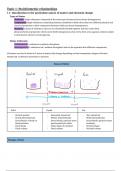Summary
Summary IB Chemistry HL Notes (2016 Syallbus) + Option D (Medicinal Chemistry)
- Course
- Institution
- Book
IB Chemistry Notes from a student who scored a 7 in IB HL Chemistry and 44/45 overall. Overall score of 88/100 in HL Chemistry. Option D (Medicinal Chemistry taken).
[Show more]



